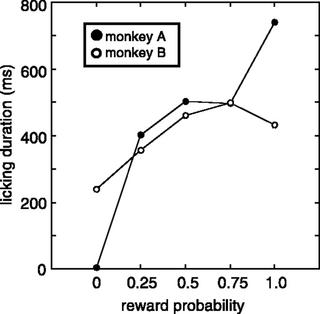God bless you goddamn monkeys

So after that mention of gambling, roll the dice on this shit....
I am writing a review article on pathological gambling disorder right now, and I've had to review all the literature on the neurophysiological basis of risk and reward. Almost all of these studies are done in animals, because even though you don't find many monkeys tossin' duckets at Mystic Lake (they prefer Treasure Island), the biological basis for addictions of all kind predates human evolution. That is to say: you can get a rat hooked on crack because the same mechanisms that got me hooked on the pipe are present in said rat.
Anyway, gambling represents a problem for the "addiction" scientific community because it doesn't involve the addition of a drug that works on neurotransmitter systems, yet it displays all of the hallmarks of chemical addiction. Even more problematic, it appears the neurotransmitters involving the reward/reinforcement of engaging in gambling behavior are pretty much identical to the reinforcement mechanisms involved in drug addiction. So, a major question is how the reinforcing stimuli in gambling behavior can "equal" the reinforcing stimuli in drug addiction, without the addition of drugs which specifically alter the neurotransmitters involved in reward.
Enter the monkey. He's been trained to engage in a task, and the sadistic researchers randomly give him a reward (fruit juice) every so often after he completes that task, all the while recording the neurotransmitter output from certain dopamine neurons in his brain (it involves lots of straws. not really). Anyway, they change the frequency of reward after completing the task in each different set of trials, so that in some sets monkey gets the reward 0% of the time, 100%, 25%, 50%, and so on. They also chage the magnitude of the reward from small to medium, medium to large, and small to large. What do they find? Single dopamine neurons have the discriminatory ability to measure the frequency and magnitude of reward, and even better, they highest amount of activation comes from a reward that comes only 50% of the time and varies from small to high in magnitude. Which is to say that monkeys, and people, get the biggest kick from the HIGHEST amount of uncertainty when engaging in a task that involves reward. When the give the monkey the reward 100% of the time, the dopamine neurons don't even fire, and when they only give them the medium to high reward possibility, they don't fire as much as with the small to large possibility.
Vegas has already figured all of this out, by the way; just think of the way a slot machine is designed. Varialbe reward from nothing to $$$$$, and they are usually set to pay out "something" just under 50% of the time. Savor all this as it fries your circuits.
Oh, and that graph comes from this study, but I just included it cause anything that has licking duration and reward probability in it gets my attention.


2 Comments:
Could these effects be multiplied if you combined the addiction of drugs with the addiction of gambling?
Like, monkey pulls the lever, and 50% of times he gets a refreshing puff of freebased cocaine.
What about other non-chemical addictions like sex or shoplifiting or something...pretty much the same factors at work?
I can see how the reward in sex and shoplifting is uncertain, and therefore stimulating and addictive. What happens if the reward system is omitted from the experiment though? Will the dopamine receptors react similarly? Or does there actually need to be a physical reward, or the reward be replaced by another reward? How important is the physical reward, could it be anything even remotely pleasurable? Could, for example, slot machines just give out small or large sips of fruit juice %50 of the time? Or would only monkeys be playing those slots?
Post a Comment
Subscribe to Post Comments [Atom]
<< Home